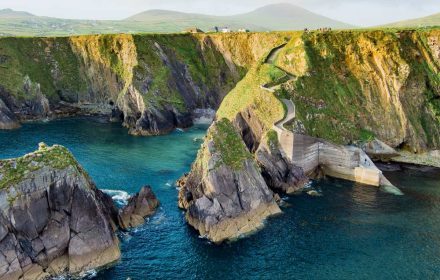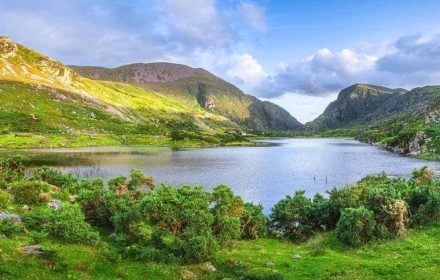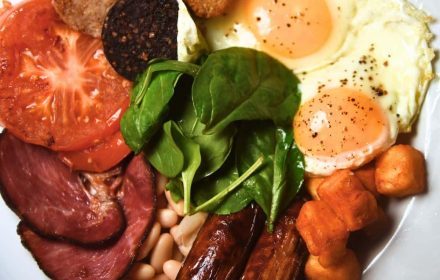This site uses affiliate links, meaning that if you make a purchase through our links, we may earn an affiliate commission.
Did you know that Dublin, Ireland’s capital, is home to the world’s first known pub, the Brazen Head, dating back to 1198? With its rich history, vibrant culture, and friendly locals, Dublin is a perfect place to explore.
If you’re gearing up for your first visit to Dublin, then this post is your ultimate guide. From navigating the city streets to discovering hidden gems, consider this your roadmap to ace Ireland’s capital.
- 1. Dublin Snapshot: Neighborhoods & Fun Facts
- 2. Tips for First Visit to Dublin
-
- 2.1. Buy The Dublin Pass
- 2.2. Buy Leap Visitor Card
- 2.3. Book Your Accommodations at Least 3 Months in Advance
- 2.4. Dress Accordingly for Dublin's Weather
- 2.5. Secure Your Entry Tickets in Advance for Popular Dublin's Attractions (List Included)
- 2.6. Take The Jameson Distillery Tour
- 2.7. Explore Dublin Castle on a Guided Tour
- 2.8. Learn About Irish Nationalism at Kilmainham Gaol Prison
- 2.9. Don't Miss The Long Room at Trinity College Library
- 2.10. Take a Stroll on Grafton Street
- 2.11. The Guinness Storehouse Is a Must-See
- 2.12. Visit a Traditional Irish Pub in Dublin
- 2.13. Explore Dublin's Bridges
- 2.14. Indulge in Dublin's Traditional Dishes
- 3. Final Intrepid Scout's Tips for First Visit to Dublin
Dublin Snapshot: Neighborhoods & Fun Facts
Dublin is split by the River Liffey into the Northside and Southside, with the city center bridging the gap.
Northside features historic areas like Stoneybatter and Smithfield, known for their trendy coffee shops and gastropubs.
Meanwhile, Rathmines and Ranelagh in the Southside are popular for their bustling cafe scenes and picturesque Georgian squares.
Here are some cool facts about Dublin:
- Dublin’s name is derived from the Irish word “Dubh Linn,” meaning “black pool,” referring to a dark tidal pool where the River Poddle entered the Liffey.
- Trinity College Dublin, founded in 1592, is home to the Book of Kells, an illuminated manuscript dating back to around 800 AD, renowned for its intricate illustrations and calligraphy.
- Dublin’s iconic Spire, officially named the “Monument of Light,” stands at 120 meters (394 feet) tall and is the tallest sculpture in the world.
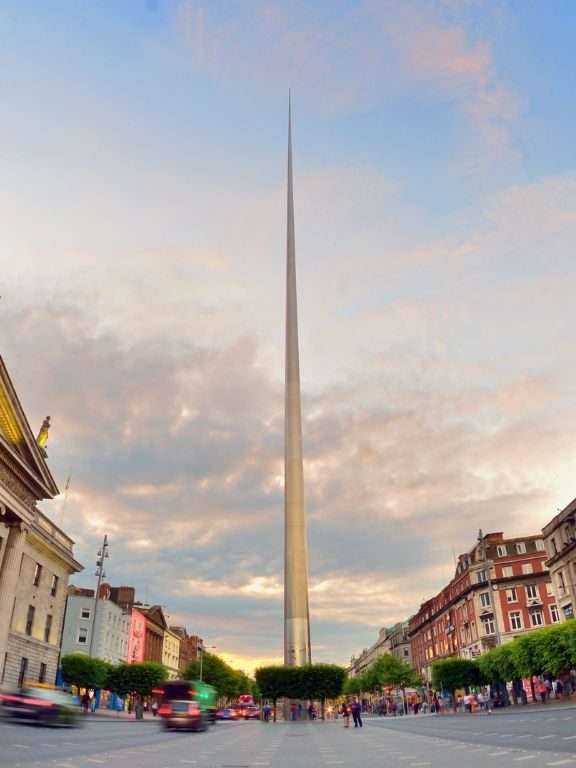
Dublin’s Iconic Spire
- Dublin is home to the oldest pub in Ireland, The Brazen Head, which has been serving patrons since 1198.
- The Guinness Storehouse, located in Dublin’s St. James’s Gate Brewery, covers seven floors surrounding a glass atrium shaped like a pint of Guinness and offers panoramic views of the city.
- Dublin’s Temple Bar district is known for its vibrant nightlife and charming cobblestone streets.
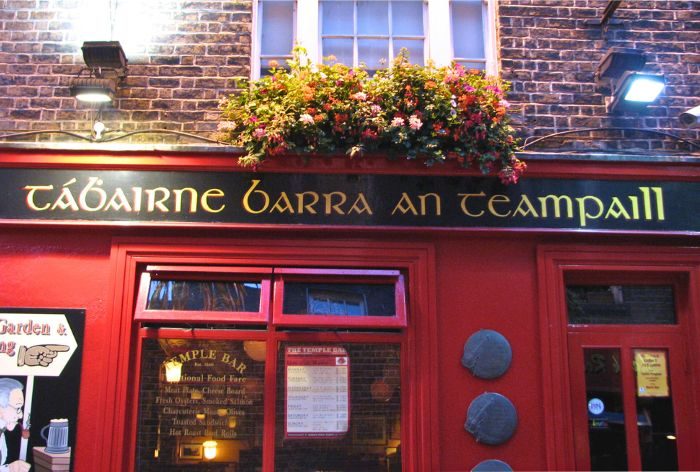
Temple Bar in Dublin
- The Dublin Zoo, located in Phoenix Park, is one of the oldest zoos in the world, opening its doors in 1831.
- Dublin’s O’Connell Street is one of the widest streets in Europe and is home to the historic General Post Office (GPO), a significant site during the 1916 Easter Rising.
- The Ha’penny Bridge, built in 1816, is one of Dublin’s most recognizable landmarks and got its name from the toll charged for crossing it, which was originally half a penny.
- Dubliners are known for their literary heritage, with famous writers such as James Joyce, Samuel Beckett, and Oscar Wilde hailing from the city, contributing to its rich literary culture.
Tips for First Visit to Dublin
Buy The Dublin Pass
The Dublin Pass is a sightseeing city card that offers access to over 30 attractions, museums, and tours in Dublin.
With options for 1, 2, 3, or 5 consecutive days, it can pretty much fit any type of itinerary.
Included in the pass are iconic landmarks such as the Guinness Storehouse, Dublin Zoo, and Jameson Distillery, as well as historical sites like Kilmainham Gaol and Christ Church Cathedral.
One of the key benefits of the Dublin Pass is skip-the-line access at selected attractions, allowing pass holders to bypass lines. This particularly advantageous at popular sites such as the Guinness Storehouse and Dublin Castle.
If you are still contemplating whether to buy it or not, here is an example of a 1-day Dublin itinerary with the potential savings if you have the pass:
- EPIC the Irish Emigration Museum (€21)
- Jeanie Johnston Tallship & Famine Museum (€14)
- Hop on Hop off bus (€33)
- Christ Church Cathedral (€10.5)
- Dublina (€15)
- The Guinness Storehouse (€28)
If you were to buy individual tickets to each attraction it would cost you €121.5. A 1 Day Dublin Pass currently costs €74, so that’s a saving of €47.5 per person.
You can purchase The Dublin Pass HERE.
Buy Leap Visitor Card
First of all, you do not need a car in Dublin!
Dublin can easily be explored on foot and to get to further away parts of the city you can use public transportation that is inexpensive and easy to use.
My recommendation is to get the Leap Visitor Card. Available in 1-day (€8.00), 3-day (€16.00), and 7-day (€32.00) durations, the card provides unlimited travel on buses, trams, and trains within specified zones, including the airport.
Just keep in mind that your chosen time period begins upon first use of the card!
For added convenience, the Leap Visitor Card can be purchased online and delivered to your home before your trip.
Book Your Accommodations at Least 3 Months in Advance
Booking accommodations in Dublin at least 3 monthsin advance is a really good idea. My recommendation is to book your accommodations the minute you know the dates of your travel. Dublin is a busy place and the best accommodations are in high demand, particularly during peak tourist seasons.
If you’re willing to splurge, The Merrion Hotel stands out as my top choice. Its superb location, spotless rooms, and exceptional turn-down service make it an excellent option for a luxurious stay. I always look forward to staying at the Merrion.
Following closely, yet at a much lower price is The Mont. It has a great location that will place you within proximity to the city center while still offering a serene and peaceful atmosphere.
Another place that I stayed at is Hyatt Centric The Liberties. It offers modern amenities. The rooms are clean and comfortable.
My recommendation is to check them all out and see what fits your budget.
Dress Accordingly for Dublin's Weather
I decided to include this section because Dublin’s weather is unpredictable and it can get very cold and it rains a lot!
So here is what you need to know: during the cooler months (October to March), temperatures range from around 4°C to 9°C (39°F to 48°F). The wettest months are typically October through January, with rainfall totals ranging from 60mm to 76mm per month. In the summer (June to August), temperatures typically range from 14°C to 20°C (57°F to 68°F), but rain showers are common.
To stay comfortable in Dublin’s variable weather conditions, it’s essential to pack appropriate clothing. Waterproof gear is a must, including a durable rain jacket with a hood and possibly fleece lining for added warmth during colder months. Water-resistant pants or trousers can also be beneficial, along with waterproof shoes or boots to keep your feet dry.
In addition to rain gear, layering is key to adapting to temperature changes.
Carrying a compact umbrella is advisable year-round to prepare for sudden showers.
Regardless of the season, comfortable walking shoes with good traction are essential for navigating Dublin’s streets, which can become slippery when wet.
Secure Your Entry Tickets in Advance for Popular Dublin's Attractions (List Included)
For a hassle-free experience, it’s recommended to reserve your entry tickets to Dublin’s popular attractions!
As soon as you have the dates of your trip, secure your desired date and time slot. You will be able to stick to your itinerary, bypass long queues, and avoid disappointment if the tickets are sold out.
My recommendation is to secure tickets to the following Dublin attractions:
- Kilmainham Gaol: Kilmainham Gaol is a former prison in Dublin with a rich history, known for its role in Ireland’s struggle for independence. You can explore the gaol on a guided tour. If you want to avoid standing in long lines, then book your tickets beforehand.
- Guinness Storehouse: The Guinness Storehouse is Ireland’s top tourist attraction, offering self-guided tours about the history and brewing process of Guinness beer. There are always lines, so save time and get your tickets ahead of time.
- Book of Kells: Housed at Trinity College Library, the Book of Kells is an illuminated manuscript Gospel book dating back to the 9th century. It is renowned for its intricate calligraphy and vibrant illustrations, representing a masterpiece of medieval art. This is a popular attraction and booking tickets in advance is highly advised to ensure access to the Book of Kells exhibition.
- Newgrange: Newgrange is a Neolithic passage tomb located in County Meath, Ireland, built around 3200 BCE. It is renowned for its remarkable architecture, featuring a large circular mound and an inner passage leading to a chamber. To explore Newgrange advance booking is required for guided tours.
- EPIC The Irish Emigration Museum: The Irish Emigration Museum located in Dublin’s historic docklands delves into Ireland’s emigration history. You can explore interactive exhibits, personal stories, and genealogy resources to learn about the Irish diaspora. Make sure to get your tickets ahead of time to avoid long lines.
- Dublin Castle: Dublin Castle is a historic landmark in the heart of Dublin, with origins dating back to the 13th century. It has served various roles throughout history, including as a royal residence, military fortress, and government seat. Save time and skip the lines! Pre-book your tickets.
Take The Jameson Distillery Tour
The Jameson Distillery on Bow Street in Dublin is the original distillery founded by John Jameson in 1780, making it one of the oldest distilleries in Ireland.
The distillery’s iconic copper pot stills, used for distillation, are meticulously maintained and are a key feature of the guided tours.
Jameson Irish Whiskey is known for its triple distillation process, a technique that contributes to its smooth and balanced flavor profile.
The Bow Street Distillery was the largest whiskey distillery in the world during the late 19th century, producing over 1 million gallons of whiskey annually at its peak.
The Jameson Distillery offers guided tours where you can learn about the whiskey-making process and enjoy tastings of Ireland’s famous spirit. The tour includes visits to historic distillery buildings, whiskey-making demonstrations, and opportunities to sample different Jameson expressions.
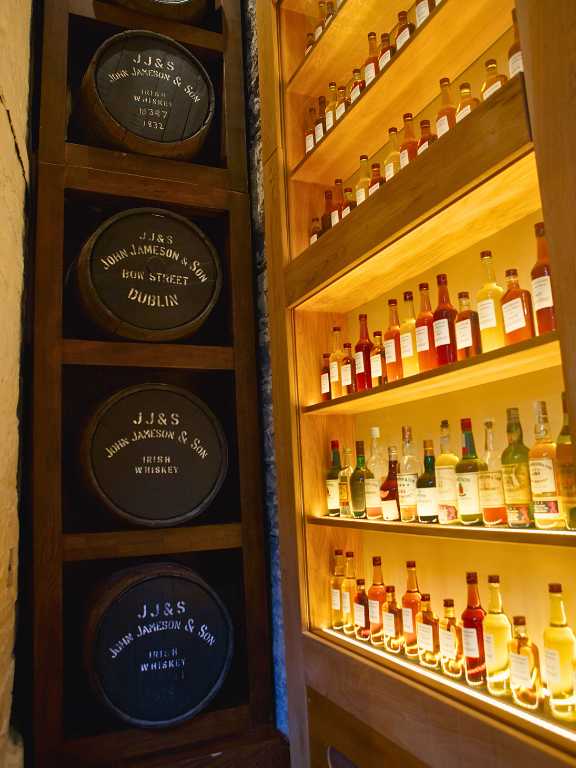
Jameson Distillery Tour in Dublin
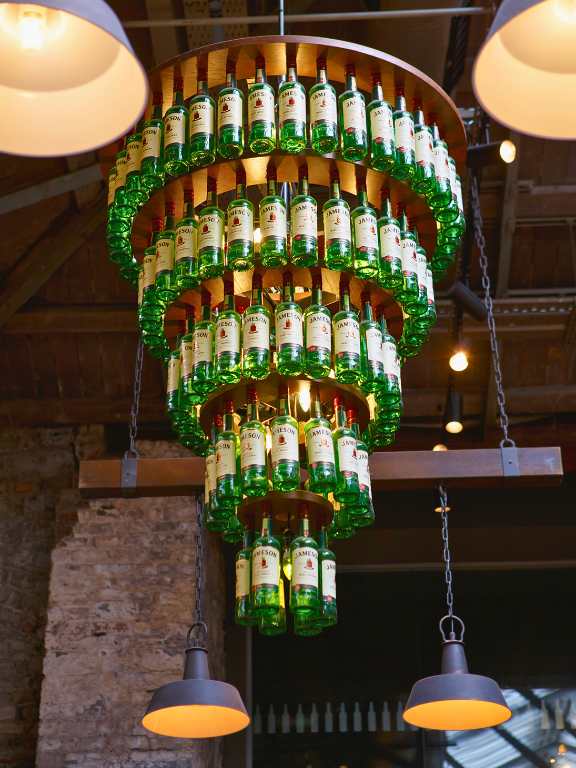
Jameson Distillery Tour in Dublin
Explore Dublin Castle on a Guided Tour
Dublin Castle has served as a symbol of Dublin’s history and heritage for over 800 years, with its origins dating back to the 13th century when King John of England constructed it.
The Record Tower, the oldest surviving structure within Dublin Castle, dates back to the 12th century and is one of the few remaining medieval structures in the city.
The State Apartments, built in the 18th century, are among the most significant parts of Dublin Castle. These opulent rooms were once used for state ceremonies and receptions and now serve as a museum.
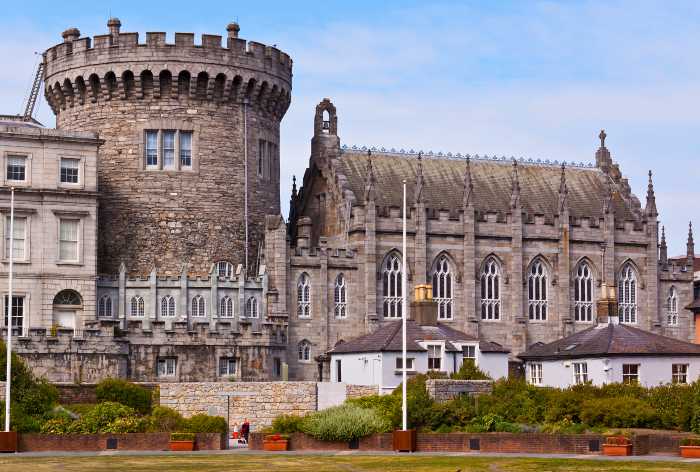
The Record Tower at Dublin Castle
Dublin Castle is also home to the Chester Beatty Library housing a vast collection of rare manuscripts, books, and artworks from around the world.
Dublin Castle has been the site of many pivotal events in Irish history, including the Easter Rising of 1916 and the handover of Dublin to the newly formed Irish Free State in 1922.
The Dubh Linn Gardens, located within the grounds of Dublin Castle, feature a pond that marks the original site of the “black pool” from which Dublin derives its name (“Dubh Linn” in Irish).
The castle’s Chapel Royal, completed in 1814, is renowned for its exquisite interior decor, including intricate plasterwork and stained glass windows depicting scenes from Irish history and mythology.
Don’t miss the opportunity to take a guided tour of Dublin Castle and learn not only about the castle’s past but also hear some fascinating tales of intrigue and royalty.
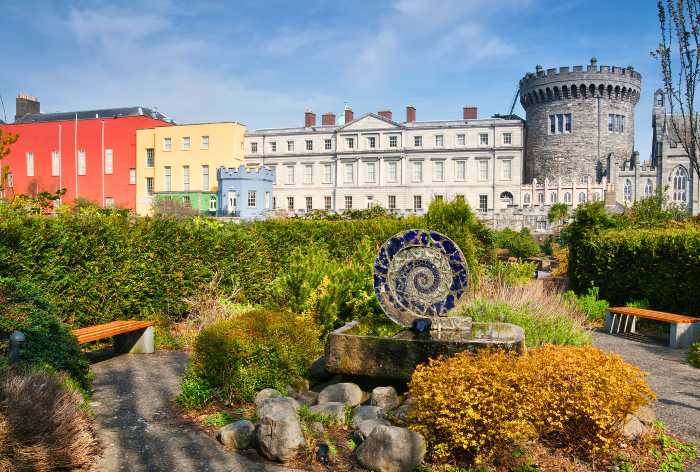
Chester Beatty Library and Dubh Linn Gardens at Dublin Castle / Tips for First Visit to Dublin
Learn About Irish Nationalism at Kilmainham Gaol Prison
Kilmainham Gaol is one of the largest unoccupied gaols in Europe, with a history dating back to the 18th century. It ceased to function as a prison in 1924 and remained abandoned for several decades before being restored and reopened as a museum in the 1960s.
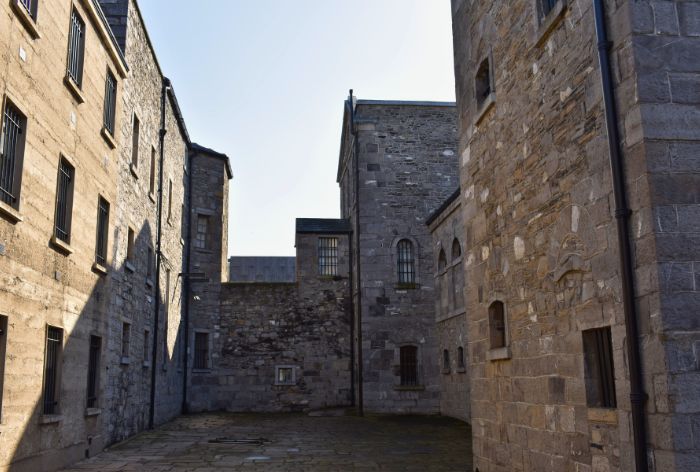
Kilmainham Gaol in Dublin
It housed many political prisoners, including leaders of the 1916 Easter Rising. Notable figures imprisoned at Kilmainham Gaol include prominent Irish nationalists such as Charles Stewart Parnell and Eamon de Valera, as well as female suffragists who campaigned for women’s rights.
You can take a guided tour and explore its austere cells, stark corridors, and haunting chapel and learn about Ireland’s turbulent past and the fight for freedom and independence.
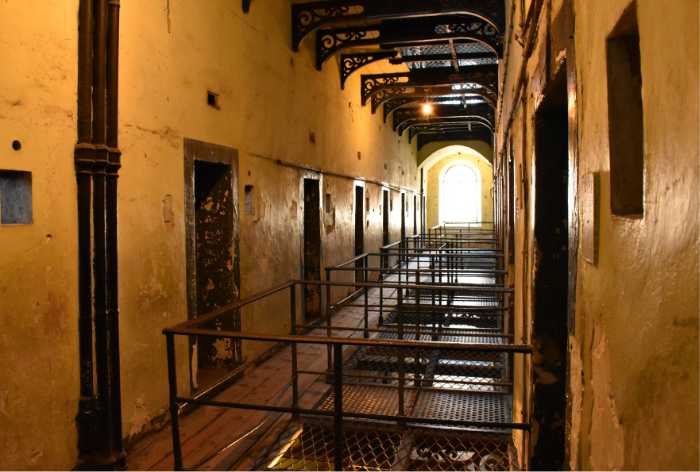
Kilmainham Gaol Tour
Don't Miss The Long Room at Trinity College Library
The Long Room at Trinity College Library stands as a testament to Ireland’s literary heritage and architectural grandeur. Spanning over 65 meters, this historic space houses an extensive collection of over 200,000 ancient books, ranging from priceless manuscripts to rare editions.
Established in 1592, the Long Room has been meticulously preserved.
At the heart of the Long Room lies the iconic Book of Kells, an illuminated Gospel manuscript dating back to the 9th century. Renowned for its intricate illustrations and vibrant colors, the Book of Kells is a masterpiece of medieval artistry and religious devotion.
Alongside this celebrated manuscript, the Long Room is adorned with marble busts depicting notable figures from Ireland’s history, literature, and academia.
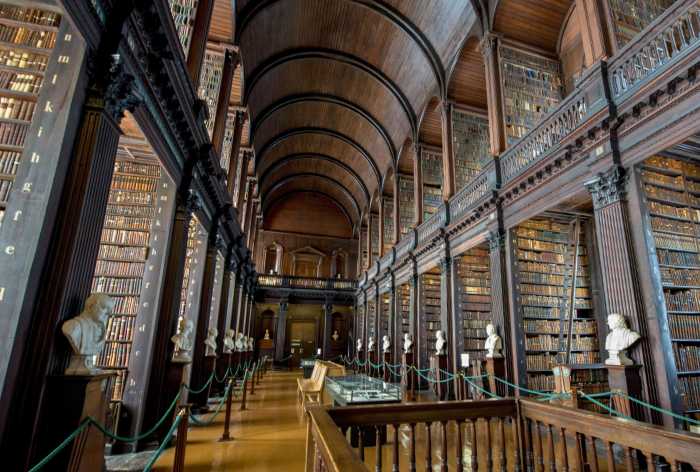
The Long Room at Trinity College Library
Take a Stroll on Grafton Street
From Trinity College, take a stroll along Grafton Street which will give you an idea of Dublin’s spirited charm.
Here, Georgian townhouses, dating back to the early 1800s, dominate the skyline. Once opulent residences, these buildings now house various businesses and professional institutions.
Stephens Green Shopping Centre, situated at the top of Grafton Street, is a nice retail experience in historic surroundings.
Grafton Street boasts several iconic landmarks. Bewley’s Café, a historic institution established in 1927, will definitely entice you with aromatic coffee!
Nearby stands the statue of Molly Malone inspired by the famous Irish folk song.
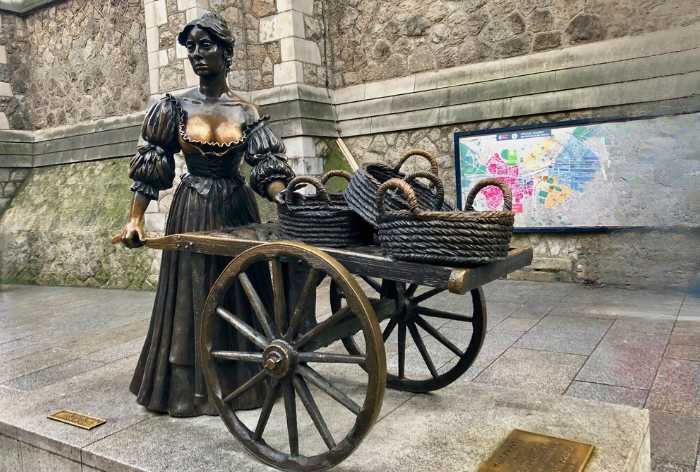
Statue of Molly Malone
Adjacent to Grafton Street lies Merrion Square, adorned with Oscar Wilde’s reclining statue and vibrant displays of local artwork. It is just fun to walk around and look at it all.
Throughout the year, Grafton Street serves as a venue for various events and celebrations. There is something fun going on all the time.
The Guinness Storehouse Is a Must-See
The Guinness Storehouse ranks among the city’s top attractions! It provides insight into the history and brewing process of Guinness beer.
Its seven-story atrium resembles a giant pint glass.
You can take a self-guided tour through the storehouse, where each floor delves into different aspects of Guinness’s history, spanning from its establishment in 1759 to its global reach today.
The Gravity Bar, located on the top floor, offers panoramic views of Dublin and serves as a prime spot for enjoying a complimentary pint of Guinness.
Visit a Traditional Irish Pub in Dublin
Make sure to head to one of Dublin’s many traditional Irish pubs for an authentic taste of Irish culture!
These establishments boast cozy interiors adorned with dark wood furnishings and often feature live music sessions.
Traditional Irish pubs offer a range of classic drinks, including Guinness and Irish whiskey, along with hearty pub fare like Irish stew and fish and chips.
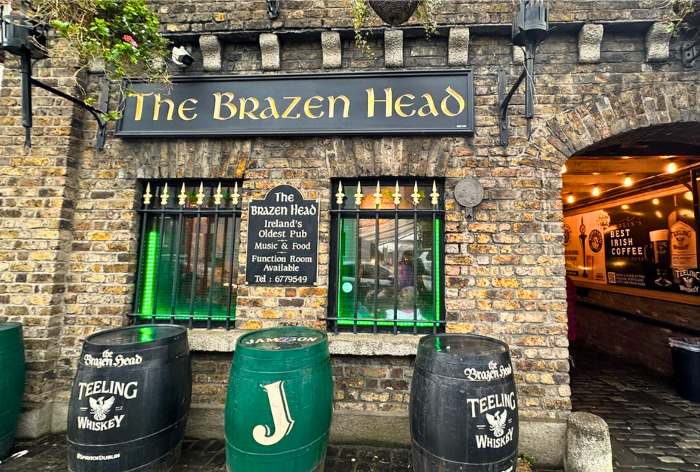
The Brazen Head Pub in Dublin / Tips for First Visit to Dublin
Explore Dublin's Bridges
Dublin’s bridges, spanning the River Liffey, show a blend of historic and modern architecture.
The Ha’penny Bridge, built in 1816, is one of Dublin’s most famous landmarks, initially charging a halfpenny toll for crossing.
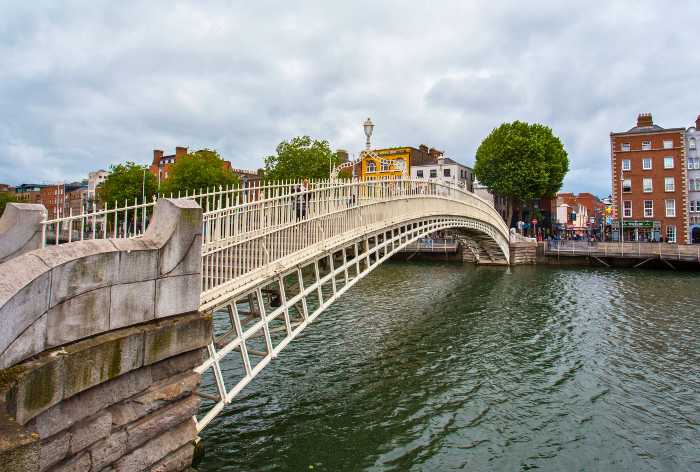
Historic Ha’penny Bridge
Samuel Beckett Bridge, opened in 2009, is a striking modern addition, featuring an asymmetrical cable-stayed design inspired by the harp, Ireland’s national symbol.
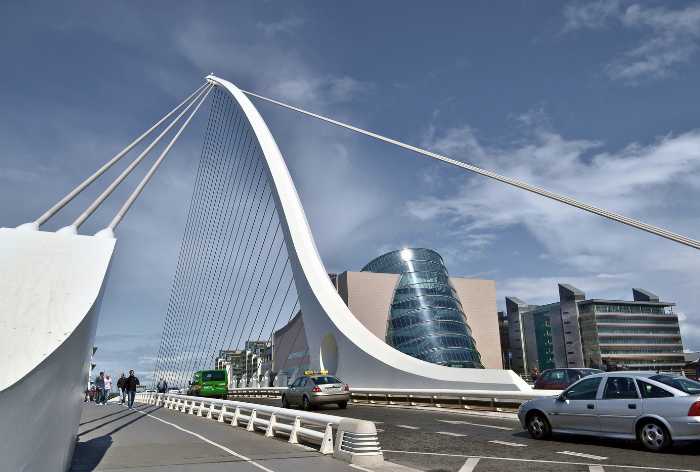
Stunning Samuel Beckett Bridge
O’Connell Bridge holds significance as one of the city’s busiest crossings, connecting the north and south sides of Dublin’s city center. Originally constructed in 1794, the current bridge boasts a distinctive wide span and is flanked by statues of Irish literary figures.
Further downstream, the Millennium Bridge, opened in 1999, provides pedestrians with a modern, sleek crossing, linking the historic Temple Bar area with the lively Docklands district.
The elegant Grattan Bridge, adorned with ornate lamp standards and decorative ironwork, serves as a picturesque link between Capel Street and Parliament Street. Originally named Essex Bridge upon its completion in 1676, it was later renamed in honor of Irish parliamentarian Henry Grattan.
Indulge in Dublin's Traditional Dishes
Hands down, Dublin offers a diverse culinary scene, that is rich with traditional Irish delicacies that are waiting to be savored.
Here is a list that you need to check off when you make it to Dublin:
- Dublin Coddle: A hearty stew traditionally made with layers of pork sausages, bacon, potatoes, and onions, simmered in a flavorful broth.
- Boxty: A versatile Irish potato pancake, enjoyed in various forms across Dublin, often served as a side dish or filled with savory fillings like bacon and cheese.
- Guinness Beef Stew: A rich and hearty stew made with tender chunks of beef, root vegetables, and a generous serving of Ireland’s famous Guinness stout.
- Dublin Bay Prawn (Langoustine): Freshly caught from the waters of Dublin Bay, these succulent crustaceans are a local delicacy, often served grilled or pan-fried with garlic butter.
- Irish Seafood Chowder: A creamy and indulgent soup featuring a medley of locally sourced seafood, including mussels, salmon, and cod, simmered in a flavorful broth with potatoes, onions, and herbs.
- Dublin Lawyer: A decadent seafood dish featuring lobster cooked in a rich cream and whiskey sauce, often served with buttery mashed potatoes or crusty bread.
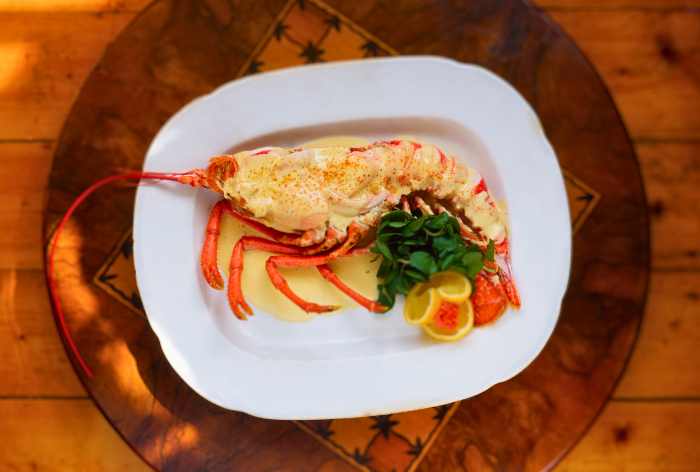
Dublin Lawyer / Tips for First Visit to Dublin
Final Intrepid Scout's Tips for First Visit to Dublin
- When you’re in Dublin, don’t miss out on the vibrant street art scene. Wandering through the city’s neighborhoods and stumbling upon colorful murals and intriguing graffiti is a must-do. It’s like uncovering hidden treasures around every corner.
- If you’re up for something beyond the usual pub crawl, I highly recommend diving into Dublin’s craft beer scene. I made it a point to visit spots like The Porterhouse Brewing Company and The Open Gate Brewery.
- Need a breather from the city buzz? Head to Howth for a day trip. That’s exactly what I did, and it turned out to be one of the highlights of my Dublin visit. Just a short train ride away, Howth offers stunning cliffside walks, mouthwatering seafood at local eateries, and a laid-back coastal vibe.
More Information About Ireland:
20 Must-See Sights and Attractions in Ireland (Your Essential Guide to the Emerald Isle)
14 Delicious Traditional Irish Foods You Must Try During Your Visit to Ireland
Perfect 10-Day Ireland Road Trip Itinerary (Detailed Map+Tips for Planning)
9 Amazing Things to Do in Killarney National Park (Maps+Tips)
22 Best Stops on the Ring of Kerry (Map+Top Attractions at Each Stop)
Perfect 1-Day Ring of Kerry Drive Itinerary
2 Days in Dublin (15 Top Things You Can’t Miss)
16 Best Stops on the Dingle Peninsula Drive (map+detailed tips)
You Might Also Like:
82 Quotes About Ireland And the Irish Spirit Celebrating the Emerald Isle
102 Beautiful Irish Proverbs and Sayings Offering Timeless Lessons
92 Irish Blessings And Wishes Embracing Joy on St. Patrick’s Day
Did You Find Tips for First Visit to Dublin Helpful? Pin it!
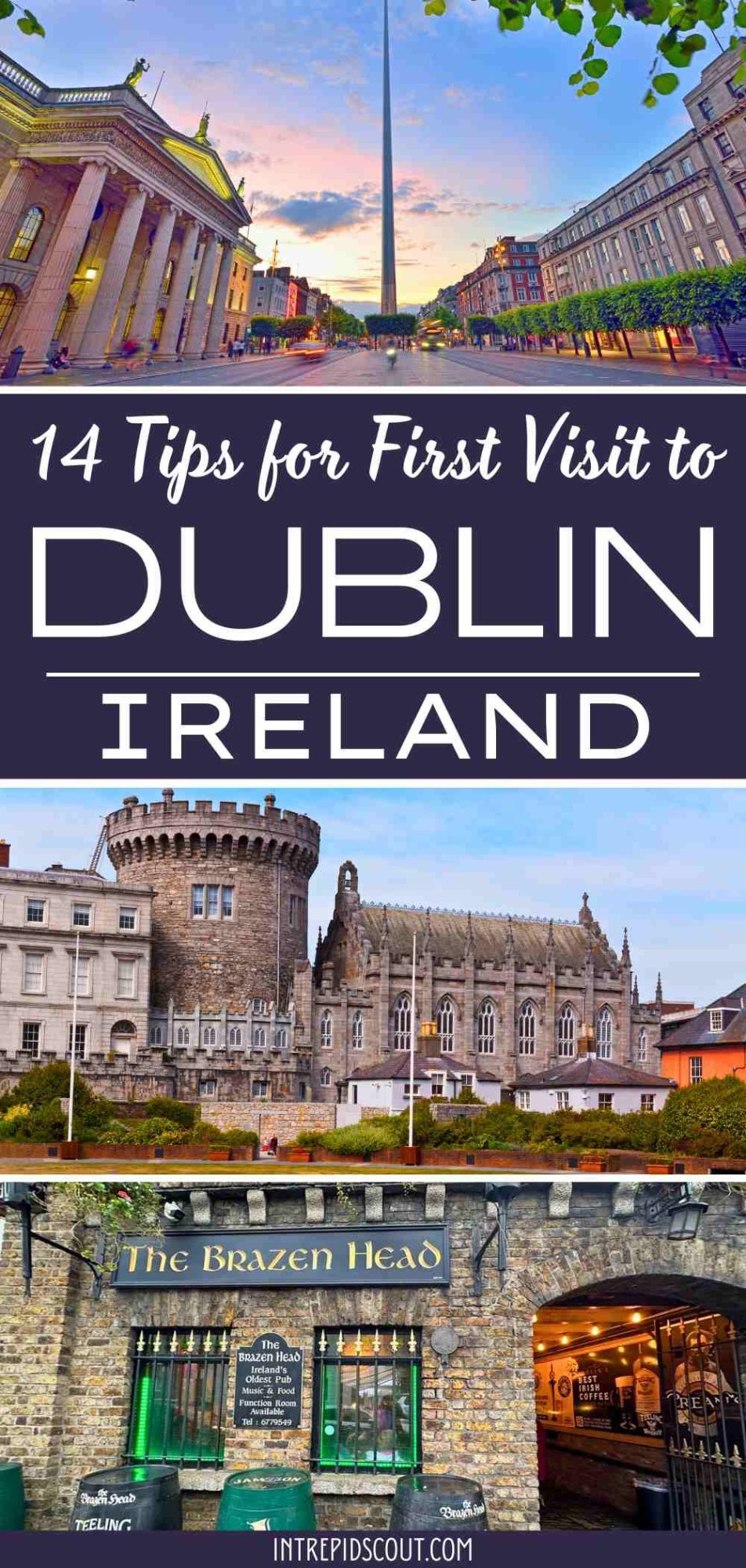
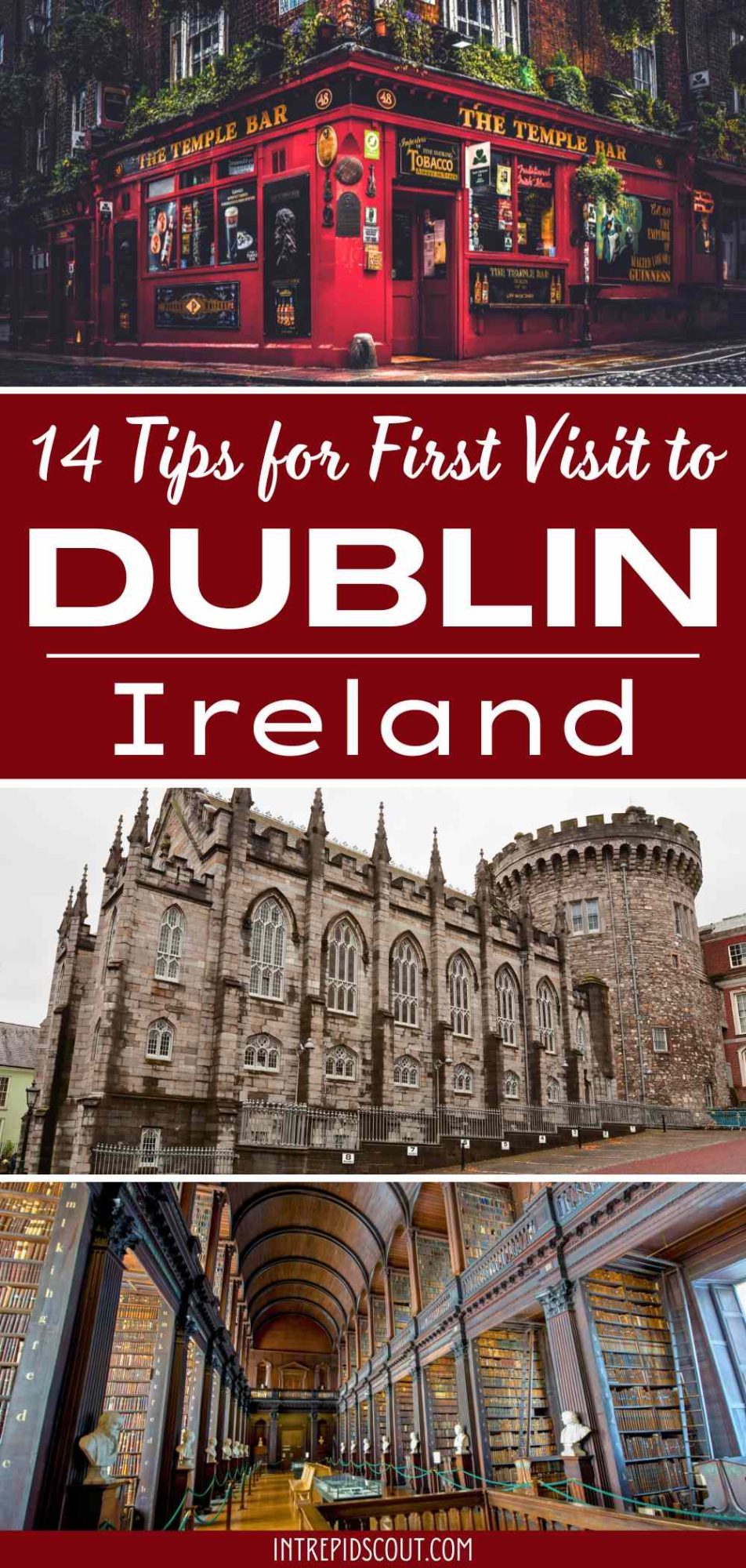
Now, It Is Your Turn, I Would Like to Hear Back from You!
Are you planning your trip to Ireland?
Please let me know! Drop me a quick comment right below!
Click on any of the images below to get inspired and to help you with the planning process for your trip to Ireland!



